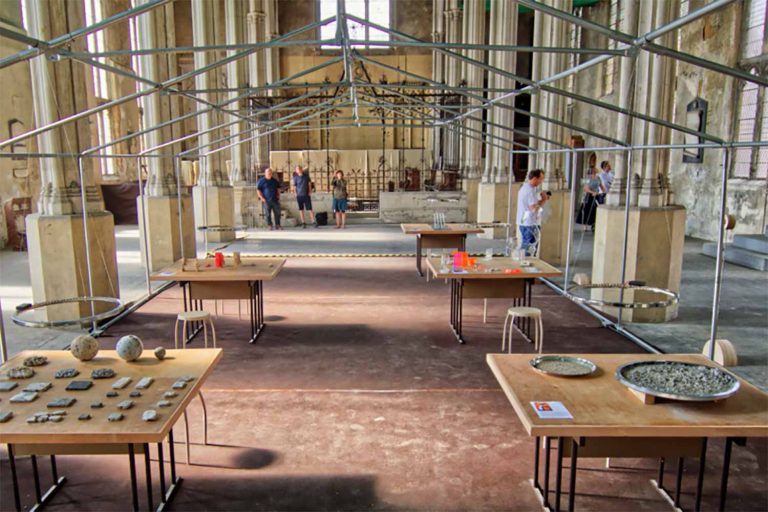Jock McFadyen: the ever-changing East End
Jock McFayden’s vistas of the East End are on display at the Royal Academy, depicting the transformation of our neighbourhood’s urban environment.
You might expect the great acclaim achieved by Jock McFadyen across his 40 year-long career to be the product of a meticulously curated plan. But when talking to the 72-year-old Scottish artist, he gives the impression of meandering through life with little forethought or design.
McFadyen’s current exhibition at the Royal Academy is titled ‘Tourist Without a Guidebook’ which rather aptly describes not only his approach to painting but his attitude towards life in general.
Artists have been coming to East London from the early days of the twentieth century, but it was in 1978 that McFadyen landed in the area. Recalling his move to the East End, McFadyen says: ‘I was only part of a herd [of artists] coming to the East End really, it wasn’t really an individual choice, it was just what you did.’
Though he moved to England at the age of 15, McFadyen retains his Scottish accent and dry sarcastic humour.
Drawn in by the area’s cheap warehouse space, McFadyen remembers the buzz of creativity and artistic innovation when he first arrived in the East End with the likes of Andrew Logan and other emerging artists at the time.
And yet McFadyen says that: ‘In the 70s there was a real feeling of malevolence in this part of London leftover from the war … there was a sort of violence in the culture of the East End that has now been supplanted by this genteel, new hipster vibe, the craft breweries and influencer coffee shops, I’ve definitely noticed that transition.’

London’s changing urban landscape has rather unwittingly become the central subject of McFadyen’s work over the past 40 years. With characteristic frankness, he says: ‘nothing, in particular draws me to the places that I paint, it’s just that London’s where I live so that is what happens to be outside the front door.’
‘The Roman Road is at the end of my street and if I need something from the corner shop I’ll be on the Roman Road’ Says McFadyen: ‘so that’s how I came to paint it.’

From scenes of Bank Underground Station, to housing blocks on the Grand Union Canal, and the Queen Elizabeth Olympic Park, McFadyen’s work is largely concerned with London’s built environment. Yet he cherishes the nature we have on our doorstep in East London. ‘Living in the East End is a bit like living in the countryside,’ he quips: ‘courtesy of Adolf Hitler and all the bombing that cleared the way for so much green space … Bethnal Green feels very countrified and spacious to me.’
Cycling along the canal from his home in Victoria Park Square to his studio in London Fields everyday, McFadyen feels the area has become rather ‘twee’ and ‘bourgeois’. Perhaps unsurprisingly, the picturesque canal boats are not the subject of McFadyen’s work.
His vistas of East London currently on display at the Royal Academy are tied together by a sense of absence, depicting the urban environment empty of the city’s inhabitants, whose presence is felt in the graffiti, litter and peeling posters hinting at a decaying past.

McFadyen’s large canvases – stretching as wide as three metres – capture East London in a state of transformation. He says he feels that the East End is a place of transition, constantly evolving as different groups of people move in and out of the area.
This sense of being adrift resonates with McFadyen. His current display, ‘Tourist without a Guidebook’, takes its title from an essay by art critic Tom Lubbock, who described McFadyen’s approach to painting as, ‘like a sightseer without a guidebook’.
This phrase struck a chord with McFadyen, saying: ‘He had perfectly described my attitude to painting places, and since that time I have carried the words close to my heart as I wander about the place not looking for anything.’

But McFadyen admits that his career as an artist has not always been so unrestrained and impulsive. His attitude towards his life and work has changed as he’s got older.
‘When you’re a young artist you’ve got to decide where you’re setting up your stall … and then at middle age you’re making prudent decisions’ explains McFadyen. ‘But then you get to a certain age and it’s a bit like looking round in the snow and you look in your footprints and you have to accept that that’s the kind of artist you’ve turned out to be.’
McFadyen smirks: ‘So I’m at the stage of hanging onto my coat tails and seeing where my work takes me … I’m not sure if I really want to know, but I’ll let you know if I find out.’
‘Tourist without a Guidebook’ is on display at the Royal Academy London until 10 April 2022.
If you enjoyed this article, then read our interview with local artist Alice Sielle.








